 To me, January is all about fresh starts and clean slates and so I always spend this month getting (even more!) organized.
To me, January is all about fresh starts and clean slates and so I always spend this month getting (even more!) organized.
But that’s not all. I also like to start the year with at least three written goals: one for my business, one for my wellness/fitness, and one for my personal development (this year it’s quilting). Setting goals, I’ve learned, is a terrific way to keep focused and produce the results you want as the months roll by.
Here then, are five recommendations for making your business goals a reality in 2014:
1. Use words you can measure. For example, “My business is generating $100,000 or more this year.” By making it measureable you know when you’re on track and when you’re not.
Make the goal feel like a stretch, but not so big that you don’t believe that it’s possible.
Also make sure to write down why you want to meet each goal. For instance, it’s rare that people want money for its own sake. We usually want money for the experiences it provides, whether that means living in a nice house, taking a vacation with the family, or having a secure retirement. Remembering the “why” goes a long way towards reaching your goal.
2. Map out a path. In the olden days (pre-2000), I used flip-chart paper and post-it notes to flesh out my goals. This year, I tried out a super-cool online tool called MindMeister (affiliate link).
Whether you use post-its or MindMeister, begin by writing your goal in the center of the paper. Next, start brainstorming about the categories of actions you’ll want to take to reach your goal.
For most small businesses, there are some pretty standard categories that you will want to consider: Marketing, Networking, Pricing, Streamlining Operations, and Product Development. Start with those and then add others of your own.
Once you have settled on your categories, write them around your goal with a bunch of connecting lines (see the MindMeister example below, using the goal of “Generate $100,000 or More this Year”).

Now, for each category, list out all the ways you plan to reach your goal. Don’t worry about getting it just right, since this is a map you’ll be working on and improving all year long.
Here’s an example:

3. Track your progress. Now that you have your plan underway, you need to figure out how you’re going to stay on track. Some of your projects will be one-time activities (like mailing a holiday card). Others, like publishing your newsletter, will repeat every month. So think of how you’ll track your progress.
I like to set up an Excel spreadsheet for this purpose and use it to track each goal. For example, once I’ve determine my revenue target for the year, I calculate the monthly sales needed and start tracking. To help me reach my goal of keeping in touch with my network, I look at the number of people on my list and the frequency of contacts per year, calculating a daily goal and tracking that, too.
Breaking up the goals for the year into monthly, weekly and even daily goals makes them more tangible and doable (and less scary).
4. Hold yourself accountable. I’m lucky enough to work with my fabulous coach Phoenix and I report in with her every week. But you can do the same thing with a friend.
Every Sunday evening I review my goals and my map and make a plan for what I want to accomplish during the upcoming week. I send all this info to Phoenix and we talk about it in our sessions.
5. Celebrate success! Take time each month to celebrate your progress and give yourself a treat for sticking with your plan (I like martinis for this purpose).
You don’t have to wait to reach your entire goal for the year either. Thanks to your progress tracking, you can see how you’re doing along the way and celebrate important milestones as you reach them.
The year is just underway and it represents a perfect, fresh start for each of us. Take time now to decide where you intend to go and to set up some simple systems for getting there. Cheers!

